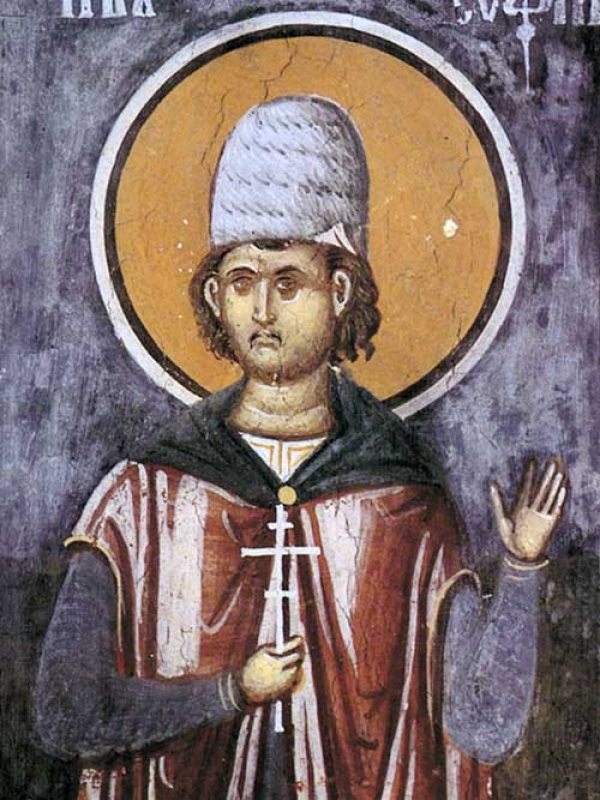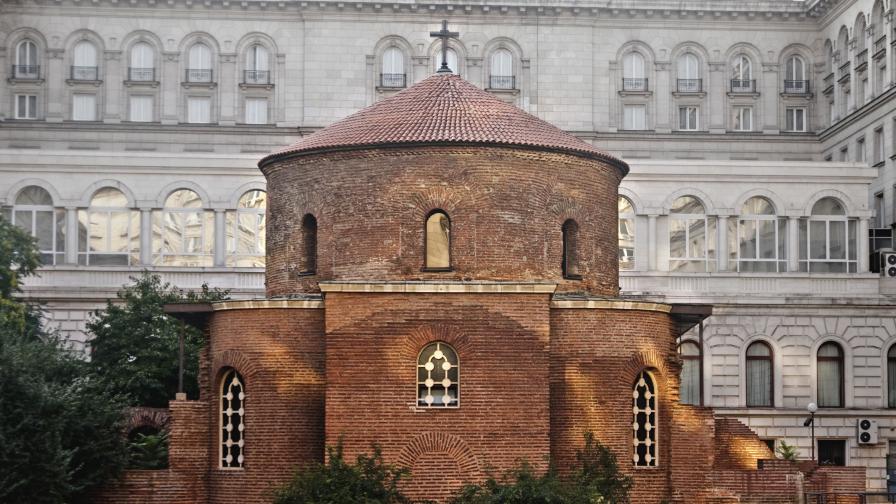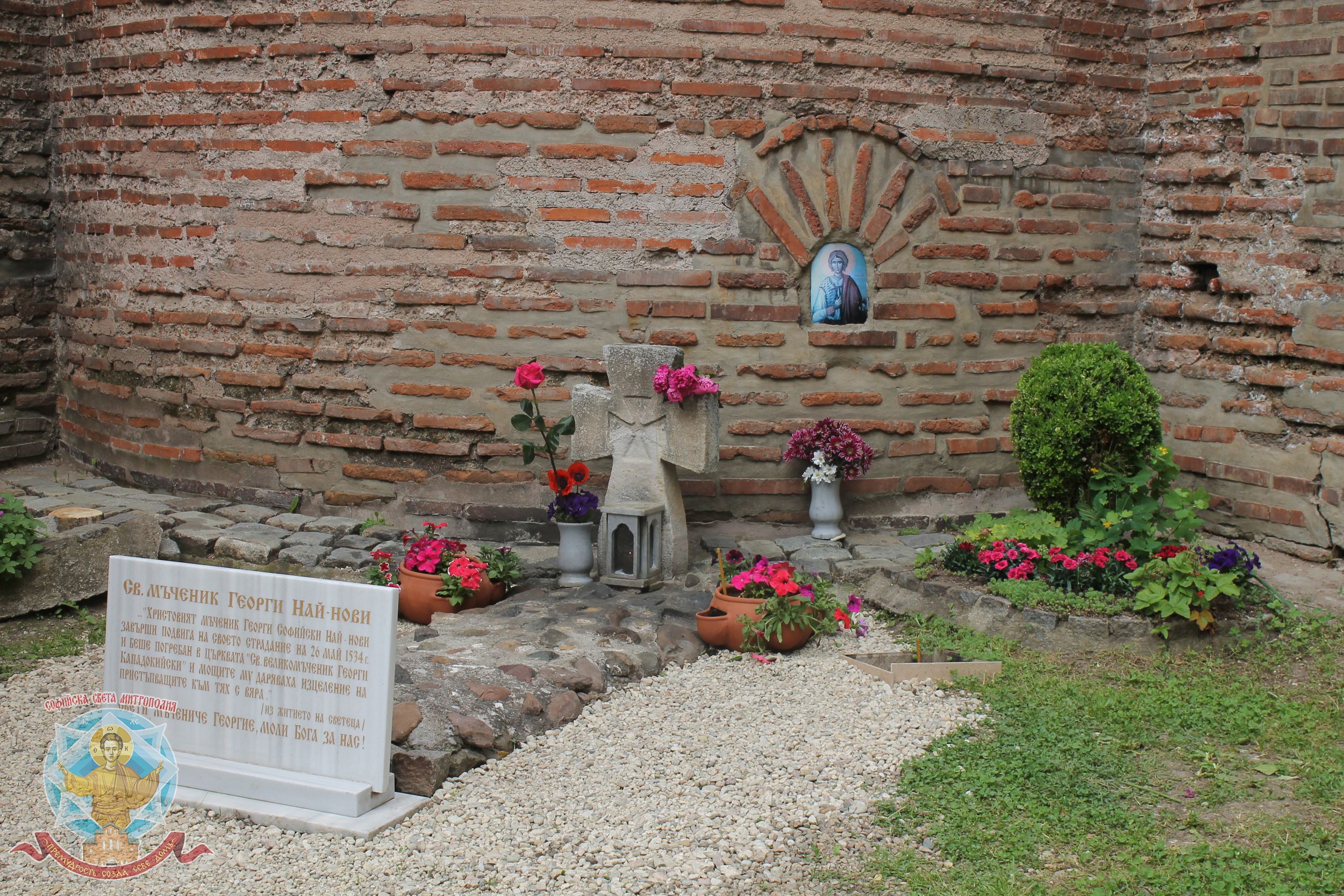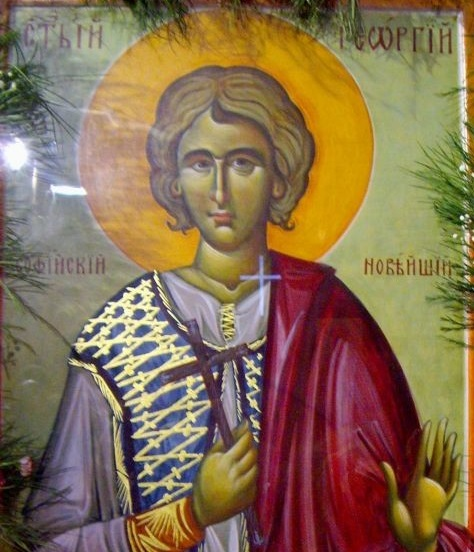
Troparion, voice 4
With a soul wounded by the love of your God, the wise George the Glorious, he preached to the ungodly, Christ God, trampled with his feeth, the Turkish heresy; and when he adorned himself with the crown of martyrdom, you ascended to the heavenly multitudes: ask Christ God to preserve your homeland, this city (Sofia) and the people who always worship your deeds.
On 26-th of May the Bulgarian Orthodox Church celebrates the memory of one of the great Bulgarian Martyr saints Saint Georgi the Newest.
С~тый Геԝ̀ргїй Софїѝскїй Новѣ̀йшїй) St. Georgi (The Bulgarian equivalent name of George) is one of the 3 saints holding the name Georgi which has confessed Christianity refused to accept islam and accepted Martyrdom for Christ in period of 1396 till year 1530 and one of the 9 famous Sofia city saints. Saint Georgi of Sofia the Newest was named after the highly venerated in Bulgarian just like in whole Christian world saint George.
St. Georgi was born in the city of Medieval Sofia (Sredetz), fortress of Serdika today’s Sofia in a family of Ivan and Maria – a wealthy and society recognized family of that time. He has born after a fervent and lengthly prayers of his parents who couldn’t have children for a long time and has been given a kid by the prayers of Saint Great Martyr George
It is important to say Georgi (the newest) celebrated on 26-th of May is a different saint from St. Georgi called “the new” whose memory in the Church is commemorated on 11-th of February.
![]()
Miracle making icon of saint Georgi Sofiyski (currently in the Church in yard of Alexandrovska Hospital Sofia)
The young Georgi quickly learned to write and read, a skills that only the most educated people usually coming from noble families could do. His favourite activity
in his free time when he was not in help of his parents was reading the Holy Scriptures.
He was grown by his parents in Christian goodness and fervency for the Christian faith.
![]()
Aged 25 he orphaned as his beloved father passed away to Christ. Georgi posessesed an extraordinary beauty, sharp mind and virtues, seeing the young man in his grief the local Turkish authorities tried as they usually do to attract the youngster to the islamic faith to make their way to interact with Georgi and do their business easier and most importantly have Georgi in their auhotirities congregation consisting only of people belonging to the islam as it was up to the Ottoman Turkish consistution law of the day.
To attract Georgi, turks first tried with hypocritical kindness and a care for the young to help him raise in the power of authorities of the city, not succeeding with that they have, they have forcefully wrapper the Muslim turban on his head and proclaimed him officially Muslim. Feeling offended by the ungodly deed of this enemies of Christ, immediately the saint throw the imposed turban on the ground and trampled on it.
The enraged muslim crowd seing his public offence for the prophet Muhammed handed him over to the Qadi in the court.
Neither the seductive promises of high office nor the cruel tortures could break the unshakable firmness of his Christian faith. The judge ordered that his body be cut into strips from head to toe and that the wounds received be scorched with dirty candles, which made the martyr’s body so hot that his face could not be seen. But all efforts were in vain.
The final verdict of the judge followed – Georgi to be hanged on the main barn in the city of Sofia, where there was a furnace for melting iron and copper ore. The execution command also stated that his body should remain on the gallows for three days in order to begin to decay, so that the faith of the Christians in the incorruptible relics of the saints and in the resurrection of the dead to be refuted and hence disgrace christianity. However, exhausted from his suffering mrtr. Georgi died at the hands of the executioners before they managed to hang him. To fulfill the command turks, anyhow hung him on a rope to show the sentence has been successfully carried out.
For three days the body hung on the gallows without any sign of decomposition, and on the contrary, an unusual fragrance of the holy relics of the martyr wafted through the barn. His mother sat under the gallows and grieving his beloved son hugged her son’s legs, staying next three three days to her son. The hanging took place on May 26, 1530 (according to other document sources in 1534). Thus on 26th of may the Church set a service in memoriam.

5-th Century Church of Rotonda St. George Centre of Sofia

Saint Georgi Sofiyski / Saint George of Sofia the Newest grave near Rotonda Church Saint George in City Center of Sofia, Bulgari
After the expiration of the sentence, the kadi handed over the body of the martyr to be buried in a Christian way, and the burial was solemnly performed by the then Metropolitan of Sofia Jeremiah in the church “St. the great martyr George the Victorious ”. Now these relics are in obscurity. The mother of the martyr died on the 40th day of George’s death and was buried at her son’s feet.
These events took place during the reign of Sultan Suleiman I Kanuni (the Legislator) also known as Suleiman the Magnificent. This “Golden Age” for the Ottoman Empire was a time of unheard of atrocities against Christians in the territory of the empire and very difficult times for the Bulgarian people. The reign of Suleiman I and his father Selim I was a time of obscurantism and severe persecution of the Christian population, a time during which many Christian new martyrs on Balkans had the courage to defend their faith.
![]()
The capture, trial and torture of St. George of Sofia The latest took place near the then Sofia. Today the place is located in the yard of the famous Alexandrovska Hospital which was a King’s hospital during the times of Kingdom of Bulgaria after liberation took place from the Turks in 1878 y.. The exact location where martyrdom occured is between street St. Georgi Sofiyski ”and“ Pencho Slaveykov ”Blvd.
There was a large stone cross with an inscription on the site, which a few years after 1944, due to the risk of being destroyed, was collected by Sofia priests and is still preserved in the altar of the church “St. Georgi Pobedonosets ”on Blvd. Partriarch Euthymius”. Until the 1940s, a liturgical procession was held from the place of death of the saint to the Rotunda on May 26.
Nowadays happily, the old Lithia tradition is being renewed and a small Lithia is conducted by Bulgarian Orthodox Christian clergy and layman.
In the garden next to the building of the Second Surgical Clinic there was a stone cross, which indicated the place and history of the martyrdom of the saint, and today a temple was built in honor of the saint.

source: Lives of the Saints. Synodal Publishing House, Sofia, 1991, edited by Parthenius, Bishop of Lefkada and Archimandrite Dr. Athanasius (Bonchev).

HOLY MARTYR GEORGE OF SOFIA THE NEWEST, PRAY GOD FOR US!
More helpful Articles

Tags: AD, after, against, age, ALL, and, ANY, Anyhow, are, balkans, Begin, beloved son, body, city, com, during, faith, Georgi Sofiyski, Islam, long time, martyr, martyrdom, muslim faith, org, php, place, reading, rejection, saint, today, www







